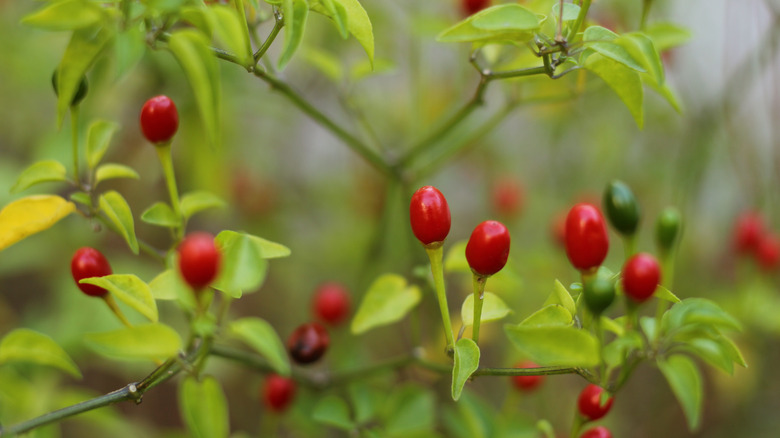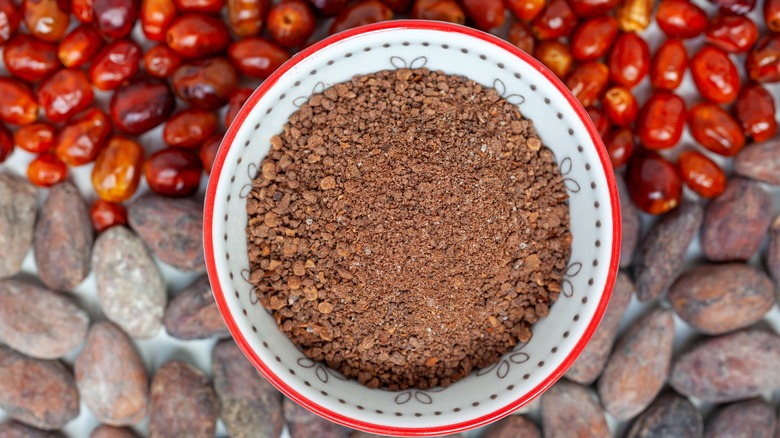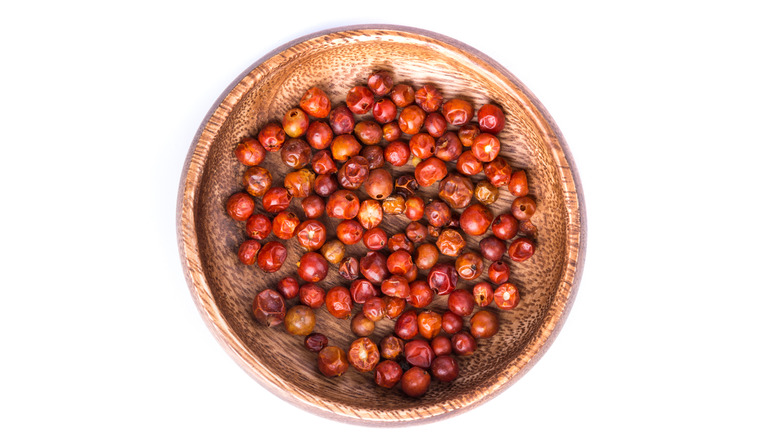What Is Chiltepin And How Do You Use It?
One of UNESCO's only "creative cities of gastronomy" heritage sites in the U.S., Tucson, Arizona boasts an amazing tapestry of culinary specialties, localized crops, and a bounty of culinary history that is specific to the area. If you like spice and you've not been acquainted with chiltepin (Capsicum annuum) before, there's much to learn about this tiny, incredibly significant chile pepper.
Linda McKittrick's illuminating "Mother Chiltepin" newsletter states that "heirloom seeds are miniature time capsules, connecting people and plants through millennia." Chiltepin is also thought to be the harbinger and genesis of all peppers, sometimes called "the parent of all domesticated chilies," as noted by The Happy Nomad. It is attributed as being the world's first chile to be domesticated. The University of Arizona notes that the chiltepin was first domesticated around 6000 to 7000 years ago. The plant remains wildly important throughout the Sonoran region and still grows today. While it resembles a tiny orb more in line with a berry than a traditional pepper, the chiltepin is indeed the progenitor of the world's chiles and one of the most unique ingredients on earth.
However, there is something essential to note when working with chiltepin: As with jalapeño or any other spicy chile, it's best to be mindful when working with chiltepin and wear gloves if possible. The capsaicin released upon cutting them can linger on your hands — and anywhere else you might touch — for quite some time, leaving an immensely uncomfortable burning sensation that is only mitigated by time.
How spicy is chiltepin?
Chiltepin originated in Mexico before being spread to Arizona, Texas, and New Mexico, primarily by birds. The seeds are said to have been spread due to birds pilfering around in their bushes, consuming some, carrying others, and inadvertently spreading the crop across states, according to Food Tank, which also notes that birds don't have receptors to detect 'spiciness,' so the chiles don't cause them to react the way that humans would. Chiltepin is the only wild chile native to the U.S. It's grown in national parks and protected therein, and is even the "official state native pepper" of Texas as of 1997, per Food Tank.
Chiltepin's minuscule stature belies its explosive spicy heat, which is complemented by a deep earthiness and a smoky flavor, according to PepperScale, which notes that the chile is "roughly six to forty times" spicier than a jalapeño, to put it into context. The instant, jarring heat of the chiltepin is unique when compared to other spicy peppers, especially in that the upfront punchy fire quickly attenuates to a smoky, subtle heat that doesn't linger. "The chiltepin's appeal is different [than the appeal of other spicy chiles]. Unlike most peppers, the chiltepin's spiciness hits the human mouth near-instantly, and will hold your undivided attention for 2 to 3 minutes, then leave you in peace and endorphins," says The Happy Nomad. Food Tank puts the chiltepin Scoville Scale rating between 50,000 to 100,000 units. Comparatively, chipotle peppers range from 2,500 to 8,000 according to MasterClass.
How is chiltepin used?
The chiltepin is also an incredibly important ingredient and crop for the indigenous populations in both the southwestern U.S. and Mexico. In cooking, they're used in their whole form, as well as dried or ground as chile powder. They're also sometimes preserved or pickled in vinegar, as noted by Native Seeds. Chiltepin can also be sun-dried, used in marinades or rubs, blended into yogurts or creamy sauces, and you'll even sometimes find it incorporated into desserts for a quick, joltingly spicy bite.
In addition to its storied history, cultural relevance, and unique heat, it is also incredibly healthful: The chiltepin allegedly bolsters the metabolism, has cancer-fighting properties, can be beneficial to diabetics, and is even said to help reduce cholesterol, according to The Happy Nomad. The University of Arizona states that it is high in vitamins A and C, releases endorphins, and has antimicrobial proteins. Food Tank notes that Mexico's indigenous Pima Bajo people used chiltepin to "relieve stomach disorders," while the Tarahumara employed chiltepin in the relief of headache symptoms. The chile is also vital from an environmental perspective: it supports native pollinators and birds, doesn't require much water, and improves "rainwater infiltration and soil retention," according to The University of Arizona.
Native Seeds states that the looming climate crisis has adversely affected the continued growth of chiltepin, but there are many scientists currently working to preserve the significant chile as best as possible in the face of cataclysmic change. With any luck, chiltepin will be here to stay.


